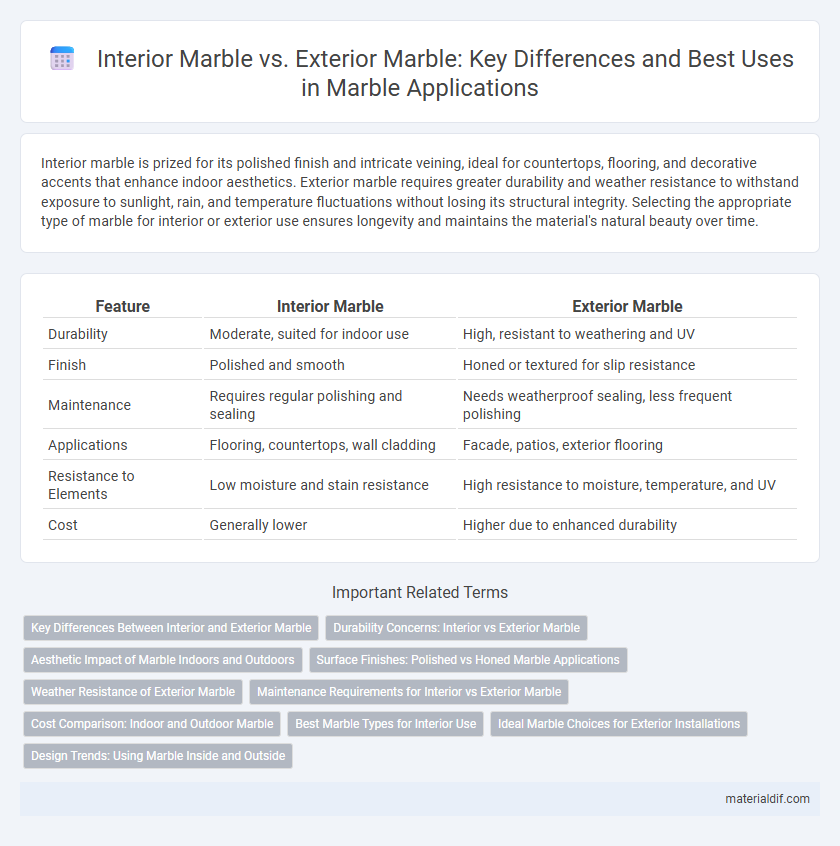Interior marble is prized for its polished finish and intricate veining, ideal for countertops, flooring, and decorative accents that enhance indoor aesthetics. Exterior marble requires greater durability and weather resistance to withstand exposure to sunlight, rain, and temperature fluctuations without losing its structural integrity. Selecting the appropriate type of marble for interior or exterior use ensures longevity and maintains the material's natural beauty over time.
Table of Comparison
| Feature | Interior Marble | Exterior Marble |
|---|---|---|
| Durability | Moderate, suited for indoor use | High, resistant to weathering and UV |
| Finish | Polished and smooth | Honed or textured for slip resistance |
| Maintenance | Requires regular polishing and sealing | Needs weatherproof sealing, less frequent polishing |
| Applications | Flooring, countertops, wall cladding | Facade, patios, exterior flooring |
| Resistance to Elements | Low moisture and stain resistance | High resistance to moisture, temperature, and UV |
| Cost | Generally lower | Higher due to enhanced durability |
Key Differences Between Interior and Exterior Marble
Interior marble is designed to withstand lower levels of weather exposure, offering polished surfaces that enhance aesthetic appeal in spaces such as kitchens and bathrooms. Exterior marble requires enhanced durability and resistance to environmental factors like UV rays, moisture, and freeze-thaw cycles, often featuring honed or textured finishes to prevent slipping and erosion. The key differences between interior and exterior marble include surface treatment, weather resistance, and maintenance requirements tailored to their specific environmental conditions.
Durability Concerns: Interior vs Exterior Marble
Interior marble typically experiences less wear and exposure to harsh elements, resulting in greater durability and easier maintenance compared to exterior marble. Exterior marble faces challenges such as weathering, freeze-thaw cycles, and UV radiation, which can cause surface erosion, discoloration, and structural weakening over time. Choosing exterior-grade marble with higher density and better resistance to moisture and temperature fluctuations is essential to ensure long-term durability in outdoor applications.
Aesthetic Impact of Marble Indoors and Outdoors
Interior marble enhances spaces with its polished finish and intricate veining, creating a luxurious and elegant aesthetic that reflects indoor lighting beautifully. Exterior marble must withstand weathering, often showcasing a more textured surface that offers a natural, timeless appeal while maintaining durability. The selection between interior and exterior marble influences design harmony, with indoor marble emphasizing refinement and outdoor marble contributing to structural grandeur and environmental integration.
Surface Finishes: Polished vs Honed Marble Applications
Polished marble features a glossy, reflective surface ideal for interior applications such as countertops and flooring, enhancing aesthetic appeal and ease of cleaning. Honed marble, with its matte, non-reflective finish, is preferred for exterior uses due to its slip resistance and ability to conceal scratches and weathering effects. Both finishes offer unique functional benefits, with polished marble adding luxury indoors and honed marble providing durability and safety in outdoor environments.
Weather Resistance of Exterior Marble
Exterior marble exhibits superior weather resistance compared to interior marble due to its density and treatment with sealants that protect against moisture, UV radiation, and temperature fluctuations. Weather-resistant exterior marble is specifically selected for its low porosity and durability, preventing erosion, staining, and freeze-thaw damage in outdoor environments. In contrast, interior marble prioritizes aesthetic appeal over weather durability, making it less suitable for exposure to harsh climatic conditions.
Maintenance Requirements for Interior vs Exterior Marble
Interior marble requires regular dusting and sealing every 6 to 12 months to maintain its polished finish and resist stains, as it is less exposed to harsh weather conditions. Exterior marble faces more aggressive wear from UV rays, rain, and temperature fluctuations, necessitating more frequent sealing--often biannually--and thorough cleaning to prevent erosion and discoloration. Both types benefit from pH-neutral cleaners, but exterior marble may require protective coatings to enhance durability against environmental elements.
Cost Comparison: Indoor and Outdoor Marble
Indoor marble typically costs more due to its higher grade, finer finish, and greater variety of colors and patterns suited for interior aesthetics. Exterior marble requires enhanced durability and weather resistance, often leading to additional treatments and higher maintenance expenses that impact overall cost. While indoor marble installation emphasizes precision and design complexity, outdoor marble expenses include structural considerations, making both applications financially distinct based on usage and environment.
Best Marble Types for Interior Use
Interior marble types like Carrara, Calacatta, and Statuario offer exceptional elegance and durability, making them ideal for indoor applications such as countertops, flooring, and bathroom vanities. These marbles feature finer grains and less porosity compared to exterior-grade marble, enhancing their resistance to staining and wear in controlled environments. Their polished finishes and diverse color patterns provide versatile design options, elevating interior aesthetics while maintaining long-lasting beauty.
Ideal Marble Choices for Exterior Installations
Exterior marble requires high durability and resistance to weathering, making dense, low-porosity stones like Carrara or Calacatta ideal for outdoor installations. These marbles withstand freeze-thaw cycles, UV exposure, and moisture better than softer interior varieties such as Crema Marfil, ensuring longevity and minimal maintenance. Proper sealing and surface treatment enhance the marble's resilience, preventing staining and erosion in exterior environments.
Design Trends: Using Marble Inside and Outside
Interior marble design trends emphasize polished finishes and intricate veining to create luxurious, sophisticated spaces in kitchens, bathrooms, and living areas. Exterior marble application prioritizes durability and weather resistance, with honed or textured surfaces enhancing facades, garden paths, and outdoor fireplaces. Combining interior elegance and exterior resilience, contemporary designs leverage marble's versatility to unify indoor and outdoor aesthetics.
Interior Marble vs Exterior Marble Infographic

 materialdif.com
materialdif.com